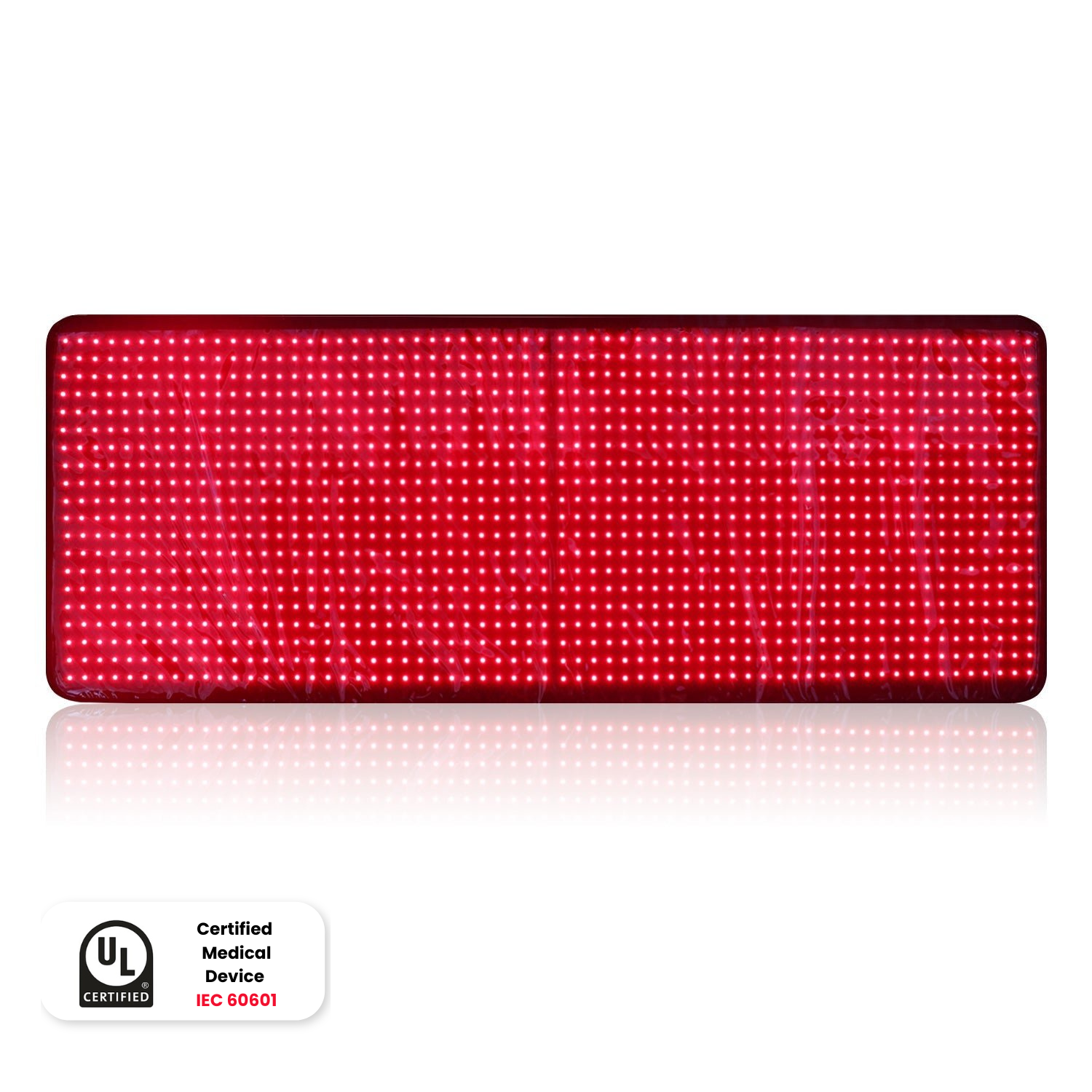DISCLAIMER: Mito Red Light devices are Class II wellness devices aimed at affecting the body through topical heating and supporting cellular function. The information provided in this article and on this site is for educational purposes only and is not intended to imply effectiveness of Mito Red Light devices for any specific application. The information provided in this article and on this site is not intended to diagnose, treat, cure, or prevent any disease, is not a substitute for consultation with a licensed medical provider and should not be construed as medical advice. Click here to read our article on potential contraindications of red light therapy..
Table of Contents
- The Origins of Red Light Therapy
- Examples of Biological Effects Caused by Light
- The Science Behind Red Light Therapy
- Collagen Production
- Benefits of Increased Collagen Levels
- Circulation
- Benefits of Increased Circulation
- Inflammation
- Benefits of Decreased Inflammation
- Cellular Energy
- Benefits of Increased Cellular Energy Levels
Red light therapy is a newer form of therapy that first came to be recognized by NASA researchers in the 1990s. While the initial discovery of red light therapy was related to the effect it has on speeding wound healing, many new discoveries have since emerged, allowing red light therapy to be used for a variety of different benefits.
Red light therapy involves using specific wavelengths of light on different areas of the body and has been used to achieve many different health benefits, from enhancing sleep quality to reducing chronic pain to improving sports performance. Understanding how the newer form of therapy actually works, however, is very important for those who are considering using it.
The Origins of Red Light Therapy
The positive health benefits of red light were first discovered in 1993 during a NASA experiment using red light LED to encourage plant growth. While the experiment successfully concluded that red light from an LED does encourage plant growth, it was an unexpected side effect that launched the use of red light in humans.
Researchers involved in the NASA plant experiment had multiple small cuts and injuries that occurred while working with the plants. One incidental finding that the experimenters noted was that their cuts and other skin lesions healed noticeably more rapidly while they were exposed to the red LED lights for hours on end. This finding led to further NASA-funded research and a spinoff company that focused on the benefits of red light in humans. NASA even uses red light therapy to reduce the side effects of cancer treatments.
Examples of Biological Effects Caused by Light
The Light had many known physiological effects on the body prior to the effects of red light being known. The best and most obvious example of light causing a physical effect on the body is the rod and cone cells in the retina that are specifically designed to absorb certain wavelengths of light and send signals to the brain, enabling sight.
Aside from the obvious biological effects that light has in creating the ability to see, there are many other biological effects of light that were known before the effects of red light were discovered. Most of these involve ultraviolet (UV) wavelengths of light.
The most noticeable effect that UV light has is the stimulation of melanin production in the skin. The skin produces more melanin when exposed to UV light to protect the skin from continued exposure to UV wavelengths of light. This effect causes the skin to turn a darker color, creating a tan.
UV light also plays a role in the production of vitamin D. While vitamin D can be ingested, it is produced at much higher levels when the skin is exposed to UV light. UV light plays a critical role in the pathway that the body uses to produce its own vitamin D.
UV light is also used in the medical setting to treat infants whose bodies are not yet able to fully break down red blood cells. During the break down of red blood cells, a byproduct is created called bilirubin. Newborn children are sometimes unable to breakdown bilirubin, causing dangerous levels to accumulate. This can lead to permanent brain damage if untreated. The main treatment used is exposure to UV lights. The lights break down bilirubin and help to avoid the health problems that these infants could experience.
The Science Behind Red Light Therapy

While red light therapy was first discovered to have potential health benefits decades ago, the science behind how this benefit occurred was not initially obvious. Even though early research came out of NASA, one of the top scientific organizations in the world, some people believed that red light therapy was nothing more than a hoax.
Today, red light therapy is understood to create positive effects by the effects that it has on mitochondria. Mitochondria are tiny cellular organs that float freely inside most cells. Researchers believe that specific wavelengths of light in the red and near infra-red (NIR) spectrum stimulate mitochondria, increasing their action. Mitochondria play an essential role in creating energy for each cell and also help to suppress inflammation in the body.
Collagen Production
Collagen is a key molecule that connects tissues and cells together. It is very abundant throughout the body but has a great impact on the health and quality of the skin and on how well joints function. According to Cleveland Clinic, exposure of the skin to certain wavelengths of red light can increase how much collagen is produced.
Increased collagen production can be especially important as we age. Collagen production decreases slowly and steadily from the time someone is in their early to mid-twenties, meaning that the body is less likely to naturally replace the collagen in your skin. This decrease in collagen levels is one of the key components in wrinkles, decreased elasticity, and other skin changes that occur with age.
Benefits of Increased Collagen Levels
Increasing collagen levels can cause the skin to be full and elastic. This can lead to a decrease in wrinkles and make the skin more resilient and durable. Collagen is also a key component in hair production. The use of red light to stimulate hair growth has been shown to increase hair growth by up to 35 percent in one study.
Collagen is also quite abundant in your joints and is the main molecule responsible for your joints gliding smoothly against each other. Increased collagen levels in your joints could promote joint health and well-being, making them more resistant to wear and decreasing joint discomfort.
Circulation
Red light therapy has been shown to increase nitric oxide levels in tissues. Nitric oxide is a natural vasodilator, meaning that it increases the diameter of your blood vessels. This increased size of the blood vessels causes increased blood flow to be able to access the areas where the nitric oxide is released. This is thought to ultimately cause increased circulation to the areas where red light therapy is used.
Benefits of Increased Circulation
Increased circulation plays a key role in wound healing. The more blood that is able to reach a wound, the more nutrients, immune cells, and proteins needed for healing are able to speed the healing process. Increased circulation not only plays a role in healing major injuries but can help to heal and improve smaller skin blemishes as well.
Increased circulation also provides additional oxygen and nutrients to the sites where the circulation is improved. This can help to reduce pain levels and may play a role in the pain relief that people use red light therapy to achieve. Increased circulation also may play a role in the effects that red light therapy can have on improved hair growth.
Inflammation
Inflammation occurs in response to an injury. Over a short-term basis, inflammation is quite helpful and is a necessary part of healing from an injury. Over a long-term basis, however, inflammation can cause chronic pain and actually inhibit healing.
Studies show that red light therapy improves inflammation in several ways. The key impacts that it has on inflammation are related to the simulation of the mitochondria, which helps provide a chemical reaction that decreases inflammation and the increased circulation that it helps to promote.
Benefits of Decreased Inflammation
Decreasing inflammation creates two key benefits that are associated with the use of red light therapy. The first is improved wound healing. Chronic inflammation leads to a state of constant irritation and inhibits the normal healing process. By decreasing inflammation, wound healing can be allowed to progress.
Another benefit to decreased inflammation is the reduction in pain that can occur. Many types of pain, especially joint and muscle pain, are related to inflammation. Inflammation causes fluid to build up and chemical changes at the area of inflammation, changing how the nerves at that site function and increasing the pain signals they send. Decreasing inflammation ultimately reduces this pain and discomfort.
Cellular Energy
Cells produce and use energy in the form of a molecule called adenosine triphosphate (ATP). The mitochondria are an essential part of ATP production, and it is not possible to produce ATP in meaningful quantities without them. Stimulation of mitochondria would naturally lead to an increase in ATP levels, increasing the energy available to the cells.
Benefits of Increased Cellular Energy Levels
The increased availability of ATP in the cells may play a role in some of the benefits that are commonly seen with the use of red light therapy. Increased energy will help the growth of cells and tissues needed to repair injuries and lead to improved wound healing. ATP also plays a role in reducing inflammation and pain.
Red light therapy is known to be connected with improved sleep. While the cause for this is still being studied, increased energy levels within the cells could play a role in improving sleep quality. Red light therapy also plays a role in improving muscle endurance and performance, a role that is likely partially due to increased circulation but many also be due to increased levels of cellular energy.
Mito Red Light provides multiple high-quality red light therapy products that are specifically designed to provide the specific wavelengths of light thought to most influence the body. We welcome you to review our selection of high-quality products or to contact one of our expert representatives at +1 866-861-6486.
Related Articles:
- Collagen: What is it and Why Does it Matter?
- Red Light Therapy - Sleep, Energy and Performance
- Everything You Need to Know About Red Light Therapy and INFLAMMATION































